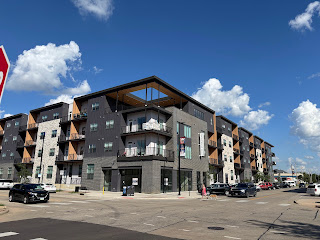 |
| Highway 100 groundbreaking (Source: youtube.com) |
For those who care about the future of Cedar Rapids, this has been either a pretty good week or a pretty bad week. The same day that city leaders and the Chamber of Commerce celebrated the beginning of the Highway 100 extension (above), word came that United Fire Group was exploring options for the American Building downtown.
This is a victory for historic preservation--it's a lovely building, over 100 years old--but its rebirth will likely come at the cost of demolishing the building next door (119 1st Av SE) that formerly housed the Convention and Visitors Bureau (Ford "United"). That building is neither old nor lovely, but the coming parking lot will hardly rank as an improvement."Urban areas need expressways," said Iowa Department of Transportation director Paul Trombino on Tuesday (Smith). Highways! Parking lots!! What century is this, anyway?
This has got me thinking about the role of the federal government in all this. In the 1980s I was profoundly affected by a book called When Federalism Works--partly because I happened to be at the Brookings Institution when they threw a party to celebrate its release, but also because of the strength and originality of its argument. The authors argued the U.S. federal government should act when states and local governments lack economic incentives to act. They specifically cite programs "that benefit low-income or otherwise especially needy groups in the community" (p. 15), because cities that act unilaterally risk attracting needy people--and their accompanying program costs--from surrounding, less-generous cities. I consider disaster assistance to be on the same plane, because disasters can easily overwhelm local resources.
On the other hand, argue the authors, cities ought to be in charge of their own economic development. "A high-quality infrastructure includes good roads, adequate utility and sanitation services, effective police and fire protection, quality schools, and pleasant parks and recreation activities" (pp. 12-13). The local incentives for creating "a potentially attractive home for productive employees and the firms that hire them" (p. 12), as well as deciding the appropriate mix of taxation and services, are obvious, and the national government can and should leave cities on their own to handle this.
Peterson et al. are nonetheless hesitant to apply this logic to transportation, arguing that the country as a whole has an interest in facilitating a nationwide network of trade and communication. Hence...
Central government support of developmental goals is warranted because, if left to itself, a community would spend for such purposes only an amount equivalent to what it expected to gain from the resultant increase in its economic activity. It would not spend funds for any portion of a project that only benefited people living outside the community. Without central government support, localities would thus underspend for development. (p. 13)I'm OK applying this logic to interstate highways, airports and rail, but when the national government funds local highway construction, it creates a moral hazard. That's what's happening with Highway 100: Without passing judgment on the specific project, the vaster portion of the financing is coming from the Iowa Department of Transportation, and as has become apparent as this year's transportation bill has stalled in Congress, about half of IDOT's money comes from the national government (Petroski). Cities thus have an incentive to act inefficiently, because someone else is bearing the cost while any economic activity that results benefits the local area. (For an extended riff on this theme, see Chuck Marohn's Strong Towns Podcast of May 22, cited below).
What would Cedar Rapids do about Highway 100 if it were on its own to finance its construction and ongoing maintenance? It's hard to say. Removing the federal government from the equation won't necessarily make it balance. Localities certainly have, in the absence of metropolitan regional government, incentives to act in ways that are individually rational (sprawling subdivisions, strip malls, tax incentives to poach each other's businesses) but collectively irrational. Despite accumulating evidence that people are moving to urban centers (Frey, Gallagher, Warlick), and that suburban sprawl is unsustainable, localities are slow to adapt to these changes. Downtown Cedar Rapids hopes for job creation, but their way to accommodate that is more parking craters, as opposed to, say, overhauling our ridiculous transit system. None of the local candidates in next week's primary election is saying anything to upset the apple cart. And the federal government, through competitive grants, can encourage states and localities to think outside the (big) box.
But despite a harrowing economic recession and the extreme fiscal stress that lingers at all levels of government, I'm seeing a great deal of same-old, same-old. We seriously need some new approaches that reflect serious thinking about what governments can and can't do to contribute to prosperous, sustainable, diverse communities.
EARLIER POSTS ON THIS SUBJECT
"What is a 'Stroad?'," 3 April 2014
"Envision CR Open House," 26 March 2014
SOURCES
George C. Ford, "Highway 100 Extension Funding Approved in 5-Year Plan," Cedar Rapids Gazette, 11 June 2013, http://thegazette.com/2013/06/11/highway-100-extension-funding-approved-in-5-year-road-plan/
George C. Ford, "United Fire Group Making Plans," Cedar Rapids Gazette, 28 May 2014, 5B
William H. Frey, "Will This Be the Decade of Big City Growth?," Brookings, 23 May 2014, http://www.brookings.edu/research/opinions/2014/05/23-decade-of-big-city-growth-frey
Leigh Gallagher, "The Suburbs are Dying, So Let's Create a New American Dream," TED Talks, 22 April 2014, http://youtu.be/FyhCyB4oXXQ
Chuck Marohn, "Podcast Show 175: Chuck on Transit," Strong Towns, 22 May 2014, http://www.strongtowns.org/journal/2014/5/22/podcast-show-175-chuck-on-transit.html#.U4dauXamUSN
Paul E. Peterson, Barry G. Rabe and Kenneth K. Wong, When Federalism Works (Brookings Institution, 1986)
William Petroski, "Road Construction Projects Face 'Fiscal Cliff,'" Des Moines Register, 30 April 2014, http://www.desmoinesregister.com/story/news/2014/04/30/road-construction-projects-face-federal-fiscal-cliff/8499339/
Rick Smith, "Local Leaders Celebrate Start of Highway 100 Project After Long Haul," Cedar Rapids Gazette, 28 May 2014, 1A, 12A, http://thegazette.com/local-leaders-celebrate-start-of-highway-100-project-after-long-haul-20140528?utm_source=thegazette&utm_medium=web&utm_campaign=discovery
Sam Warlick, "America's Cities are Still Booming, Says New Census Data," Smart Growth America, 23 May 2014, http://www.smartgrowthamerica.org/2014/05/23/americas-cities-are-still-booming-says-new-census-data/







.JPG)
.JPG)
.JPG)
.JPG)
.JPG)
.JPG)
.JPG)
.JPG)

.JPG)



.JPG)





















